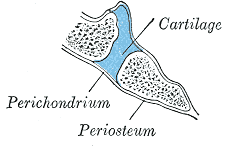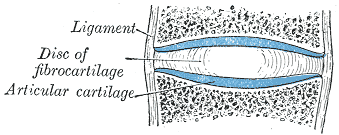The key difference between synchondrosis and symphysis is that synchondrosis is a cartilaginous joint where bones are joined by hyaline cartilage, while symphysis is a cartilaginous joint where bones are joined by fibrocartilage.
There are cartilaginous joints between bones. These connections are important to maintain the structure of the skeletal system. Depending on the type of connection or joint, the properties of the particular joint varies. Their activity depends on the nature of the cartilage involved and the place of distribution. Synchondrosis and symphysis are two types of cartilaginous joints that connect bones. Synchondrosis joins two bones by hyaline cartilage while symphysis joins two bones by fibrocartilage.
CONTENTS
1. Overview and Key Difference
2. What is Synchondrosis
3. What is Symphysis
4. Similarities Between Synchondrosis and Symphysis
5. Side by Side Comparison – Synchondrosis vs Symphysis in Tabular Form
6. Summary
What is Synchondrosis?
Synchondrosis is a cartilaginous joint. The bones of this joint are connected together by hyaline cartilage. Further, this joint can either be temporary or permanent. The temporary synchondrosis is the growth plate of a growing long bone structure. Thus, in the long bone, the synchondrosis is located at the junction of the diaphysis and epiphysis. Thus, this affects the growth of long bone. Synchondrosis is also present at the joints between the ileum, ischium and pubic portions at the hip bone. These are examples of temporary synchondrosis.

Figure 01: Synchondrosis
The permanent synchondrosis is situated in the thoracic cage. The main point at which the joint is formed is the first sternocostal joint, between the first rib and the manubrium of the costal cartilage. There is less movement between the synchondrosis joints. Therefore, permanent joints are more stable due to this factor.
What is Symphysis?
Symphysis is the second type of cartilaginous joint where the fibrocartilage joins two bones. It is stronger in nature in comparison to the synchondrosis. The strength of the symphysis is more stable because it contains many bundles of very thick collagen fibres. Thus, this gives the structure more resistance and it resists the pulling and the bending forces. Due to the high rigidity, the movement between the bones is hindered.

Figure 02: Symphysis
The distribution of the symphysis is seen in the pubic portions of the right and left hip bones. It is also present in the site which unites the manubrium to the sternum. The symphysis joints are also distributed in between vertebrae of the vertebral column. The characteristic feature of the symphysis joints located at the vertebral column provides strength to withstand the shock created on the vertebral column.
What are the Similarities Between Synchondrosis and Symphysis?
- Synchondrosis and symphysis are two types of cartilaginous joints.
- Therefore, both joints are cartilaginous in nature
- Both are situated to facilitate connections between the bones.
- They provide support and rigidity to the skeletal system; hence, both are a part of the skeletal system.
What is the Difference Between Synchondrosis and Symphysis?
Synchondrosis and symphysis are two types of joints which are cartilaginous in nature. Since both joints are cartilaginous, the principle factor of differentiation is the type of cartilage. Thus, the key difference between synchondrosis and symphysis is that synchondrosis joints will have hyaline cartilage while symphysis joints will have fibrocartilage. Due to this differentiation in the type of cartilage, the individual properties of the two types of junctions also differ in terms of their movement, rigidity, flexibility and strength.
The below infographic summarizes the difference between synchondrosis and symphysis.

Summary – Synchondrosis vs Symphysis
Synchondrosis and symphysis are two types of joints that are situated between bones. Synchondrosis will have hyaline cartilage in between the bones while in symphysis, fibrocartilage is present between the joints. Thus, depending on the type of cartilage, the strength and rigidity also vary. The strength and rigidity are high in the fibrocartilage because it handles bundles of fibres stacked together in comparison to the symphysis joints. This summarizes the difference between synchondrosis and symphysis.
Reference:
1. Rice University. “Cartilaginous Joints.” Anatomy Physiology, 6 Mar. 2013, Available here.
Image Courtesy:
1. “Gray297” By Henry Vandyke Carter – Henry Gray (1918) Anatomy of the Human Body (See “Book” section below)Bartleby.com: Gray’s Anatomy, Plate 297, (Public Domain) via Commons Wikimedia
2. “Gray298” By Henry Vandyke Carter – Henry Gray (1918) Anatomy of the Human Body (See “Book” section below)Bartleby.com: Gray’s Anatomy, Plate 298, (Public Domain) via Commons Wikimedia
ncG1vNJzZmivp6x7pbXFn5yrnZ6YsqOx07CcnqZemLyue8OinZ%2Bdopq7pLGMm5ytr5Wau26%2F2Keaoaeemb%2Bwv8isZJqmlGLAurnPobCsoaNk